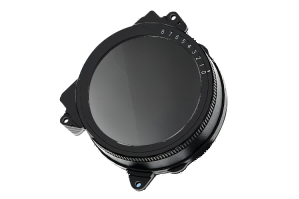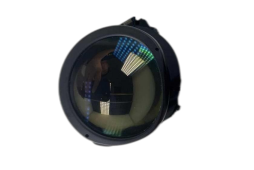Pancake Optics
The VR Pancake optic engine is designed specifically for virtual reality (VR) applications. Unlike the commonly used Fresnel lenses, Pancake optic engine uses a unique optical design that significantly reduces their thickness and weight, making them ideal for portable VR headsets.
One key feature of VR Pancake optics is the folding optical path, after the image source enters the lens with a semi-reflective and semi-transmissive function, the light bounces back repeatedly between the lens, phase delay film, and reflective polarizing film, finally exiting from the reflective polarizing film. The lens group does not need to maintain a certain distance from the display screen, which can reduce the thickness of VR headsets, making them more compact and smaller in overall volume.
VR optic engines on the market include Fresnel lenses and pancake optics. Due to their thin and light design, VR glasses using pancake optics can reduce volume by up to 2/3 compared to those using Fresnel optics, as can be seen in the comparison between Quest 1 (Fresnel) and Quest 2 Pro (Pancake). Apple MR Glass will also use pancake optics and Pancake optics are becoming the mainstream optic solution for VR glasses.
So, what parameters should you consider when choosing a suitable pancake optic engine? Here are some tips.
FOV
The Field of View, or FOV, is an essential specification of AR glasses. It determines the range of virtual objects that a user can see through the display of their glasses. In simplified terms, it's like the "window" through which the user sees the virtual world.
Exit pupil distance
Exit pupil distance, also known as eye relief, is the optimal distance between the eyepiece and the user's eye that provides the best viewing experience. In AR glasses, it's critical to ensure that the exit pupil distance is optimized to maximize comfort and minimize eye strain without affecting the quality of the image.
Eyebox
The Eyebox, or exit pupil diameter, is the area where a user's eyes can be positioned while still seeing the full field of view. If the eyebox is too small, it can cause discomfort and disorientation, while too large an eyebox can lead to decreased image quality and a bulkier design.
MTF
MTF, or Modulation Transfer Function, is a measure of the optical system's ability to transfer contrast from the object to the image plane. In AR glasses, MTF determines the clarity and sharpness of the display, which is essential for providing the user with a realistic and seamless AR experience.
Ghosting
Ghosting in VR Pancake optic engine is often caused by unwanted reflections and other optical distortions. These reflections can occur when light bounces off surfaces within the optics and interferes with the primary image, resulting in a secondary "ghost" image that appears faintly overlaid on top of the primary image.
We are professional manufacturers since 2016. Below is a paritial list of our pancake optics that have already been launched.
Showing all 7 results


